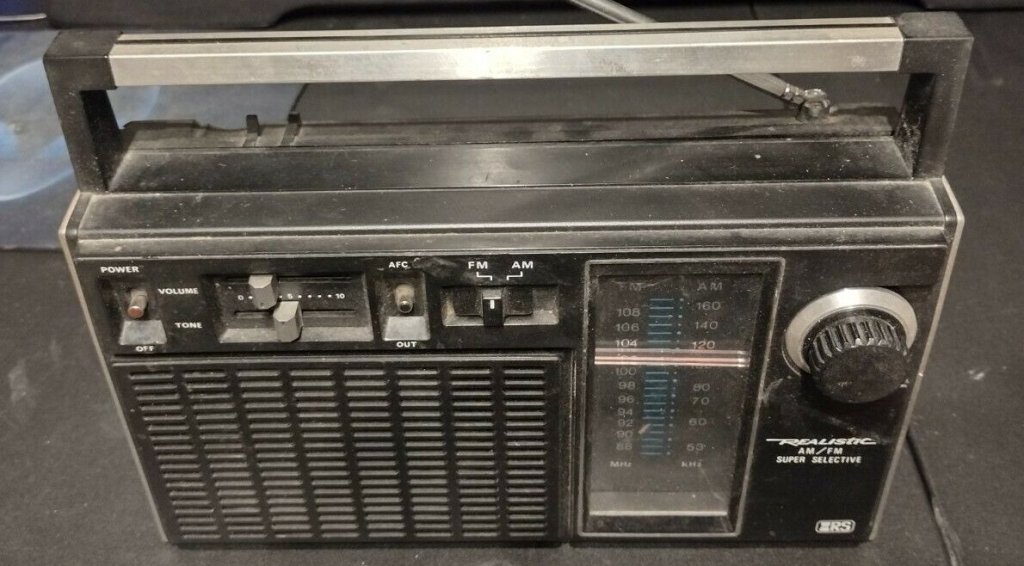Realistic 12-665 AM/FM Portable Radio (Sony TFM-7250W Clone)
…and a look at clone radios in general…

For many years I had been curious to check out Radio Shack’s Realistic 12-665 radio because it so closely resembles one of my favorite portables, the Sony TFM-7250W. The whole topic of radio clones is an interesting one and has been around for decades. Some very popular radios of the past, like the Zenith Royal 500, were copied by many manufacturers who sought to capitalize on the original radio’s quality reputation. Most of those were cheap copies with poor performance. Others, such as Radio Shack’s Optimus 12-603 which strongly resembled GE’s Superadio III were marginally cheapened and performed reasonably well although not quite as well as the original, while still others, such as Radio Shack’s DX-398 were identical to the original (in this case the Sangean ATS-909) only with different external markings. Nowadays many radios are marketed under different brand names and are either identical or extremely similar to the OEM manufacturer’s version. Eton for example markets many Tecsun radios under different model names and many of today’s Chinese companies market the same or similar radios under more than one brand name.
Getting back to the Realistic 12-665, it was marketed between 1976 – 1981 and initially sold for $39.95 and later $44.95. It caught my attention at the time because I owned the Sony version which retailed for more…if I recall it was more like $69.95, and it looked so similar I wondered if it was really the same radio or a cheapened copy. I forgot about this for all these years until I ran across one on eBay for a cheap price because it was so filthy, so for $30 with shipping I would finally satisfy my curiosity.

If you read my Sony TFM-7250W article, my 12-665 arrived in equally dirty condition. It had a dead bug inside, a badly rusted positive battery contact and had been in a smoker’s house. (In fact it arrived with dead batteries inside which had expiration dates of 2008, more than 14 years ago). But again, I was lucky in that most of this stuff cleaned up pretty well. I mainly used Windex to cut through the grime, 91% Isopropyl alcohol to clean the interior, Novus Plastic Polish for the cabinet parts including the dial glass and Rust-oleum Rust Dissolver with a wire brush on that battery contact. Although it certainly does not look mint it looks pretty nice and is fine for display and use. Operationally it had no problems so all that was left was to touch up the alignment as needed.


So…what kind of clone is the Realistic 12-665? A good one but with some interesting differences.

Sony’s “Super Sensitive” becomes Radio Shack’s “Super Selective”. It is clear that Sony didn’t want Radio Shack to copy their well-known brand slogan…they had been describing their top models as Super Sensitive for more than a decade and had many models in that line. I’m also sure that the marketing people at Radio Shack felt that Super Selective was just as catchy…if they couldn’t call their radio Super Sensitive it was certainly better than nothing. I can tell you that it had nothing to do with any differences in the radio’s circuitry or performance as we will see.

Controls: The most obvious difference is the slider volume and tone controls on the 12-665 versus the traditional rotary controls on the Sony. For a while in the 70’s slider controls were very trendy and although they remain the norm for some equipment such as audio control boards they gradually faded (no pun intended) from consumer electronics.
The headphone jack was moved from the side panel to the rear panel…I suspect this was an assembly simplification as the jack is now part of the PCB and not a separately wired and mounted component.
Sony’s very cool LED Tuning indicator right on the dial pointer was eliminated…this was not only a cost cutting move but also kept the Sony a notch above in the public’s perception.
The three above differences necessitated a change in the PCB layout but it seems the board was only changed to accommodate these changes…the basic layout, circuitry and internal adjustment layout are all identical to the original Sony board. This means you can use the Sony service information.
Two more interesting changes: On the Realistic, the dial scale markings are printed on the black plate behind the dial pointer, while on the Sony version that back plate is solid black and the lettering is on the inside of the clear plastic dial cover. I have no idea why they would change that, but I also noted on the back panel of the two radios that while the Realistic radio was made in Korea my two Sonys are marked differently – one says Tokyo and the other one says Hong Kong. Moving production locations was not uncommon.
Performance Comparisons: Identical in all respects which means that except for the deletion of the LED Tuning Indicator the Realistic version was indeed a bargain, again remembering that the 16-655 sold for $42.95 compared to the Sony TFM-7250W at $69.96. I do think the Sony has slightly superior cosmetics and that nice Tune LED but admit that is really splitting hairs. The 12-665 incorporated a few design changes, probably to reduce costs but the basic circuit is the same so it is a worthy model…as clones go, it is a good one. There was also a version which added Weather Band and was sold as the Realistic 12-653 for $42.95…only a $3 difference! By 1981 their prices had increased to $44.95 and $49.95…all great deals for the day.
I’m happy to have finally been able to look inside the Realistic 12-665 and answer those questions I’ve had all those years. As it turns out it was well worth the look.
You must be logged in to post a comment.